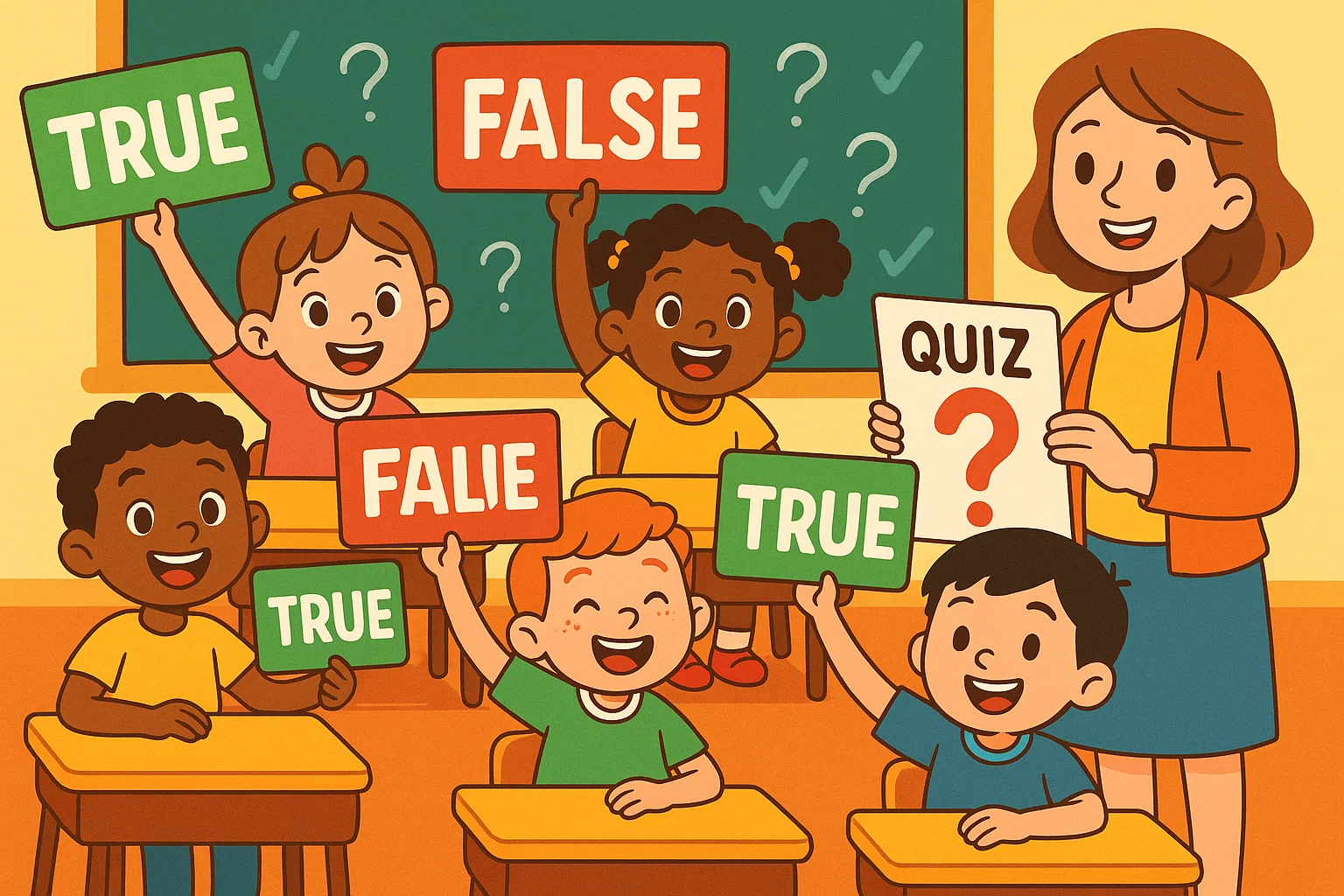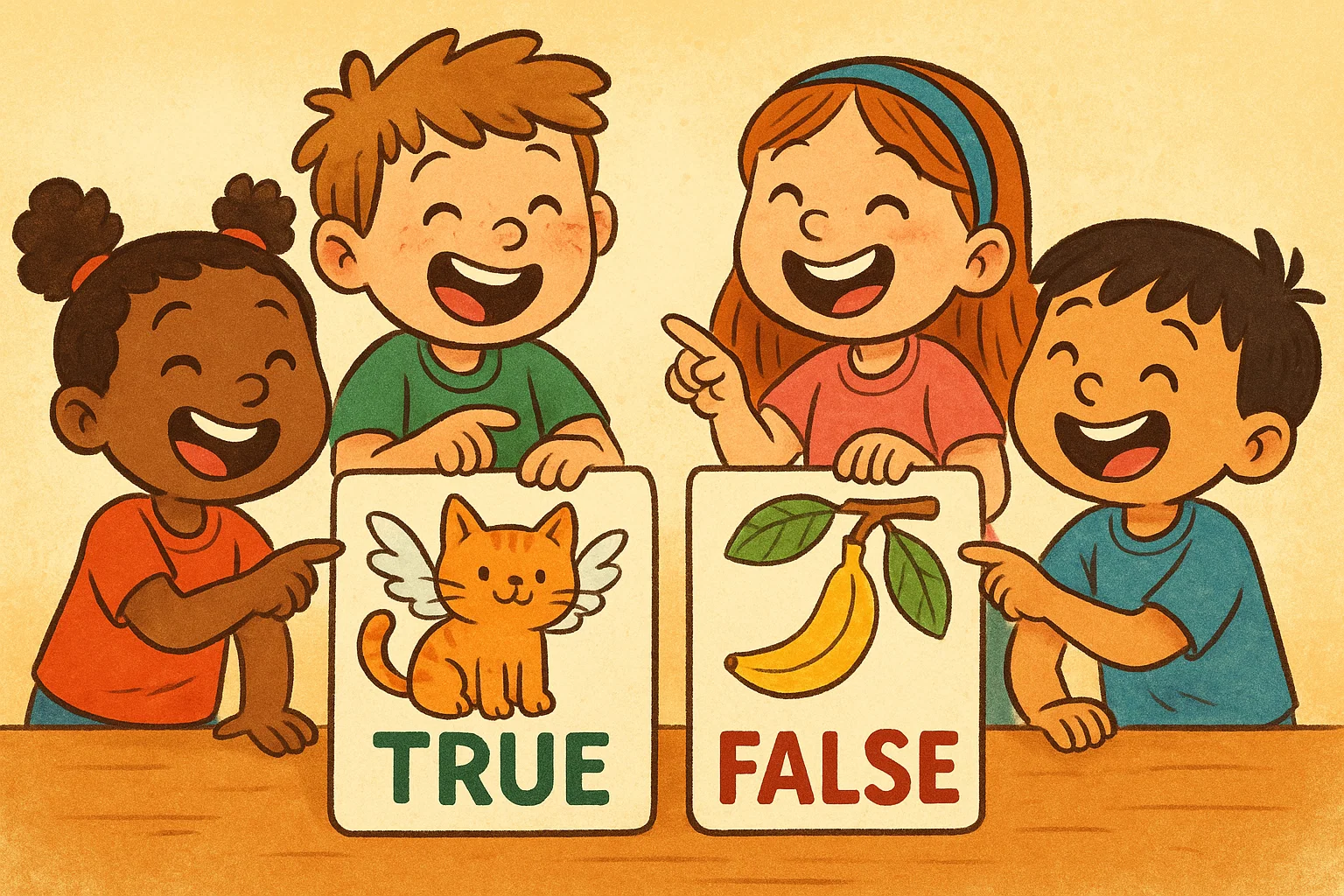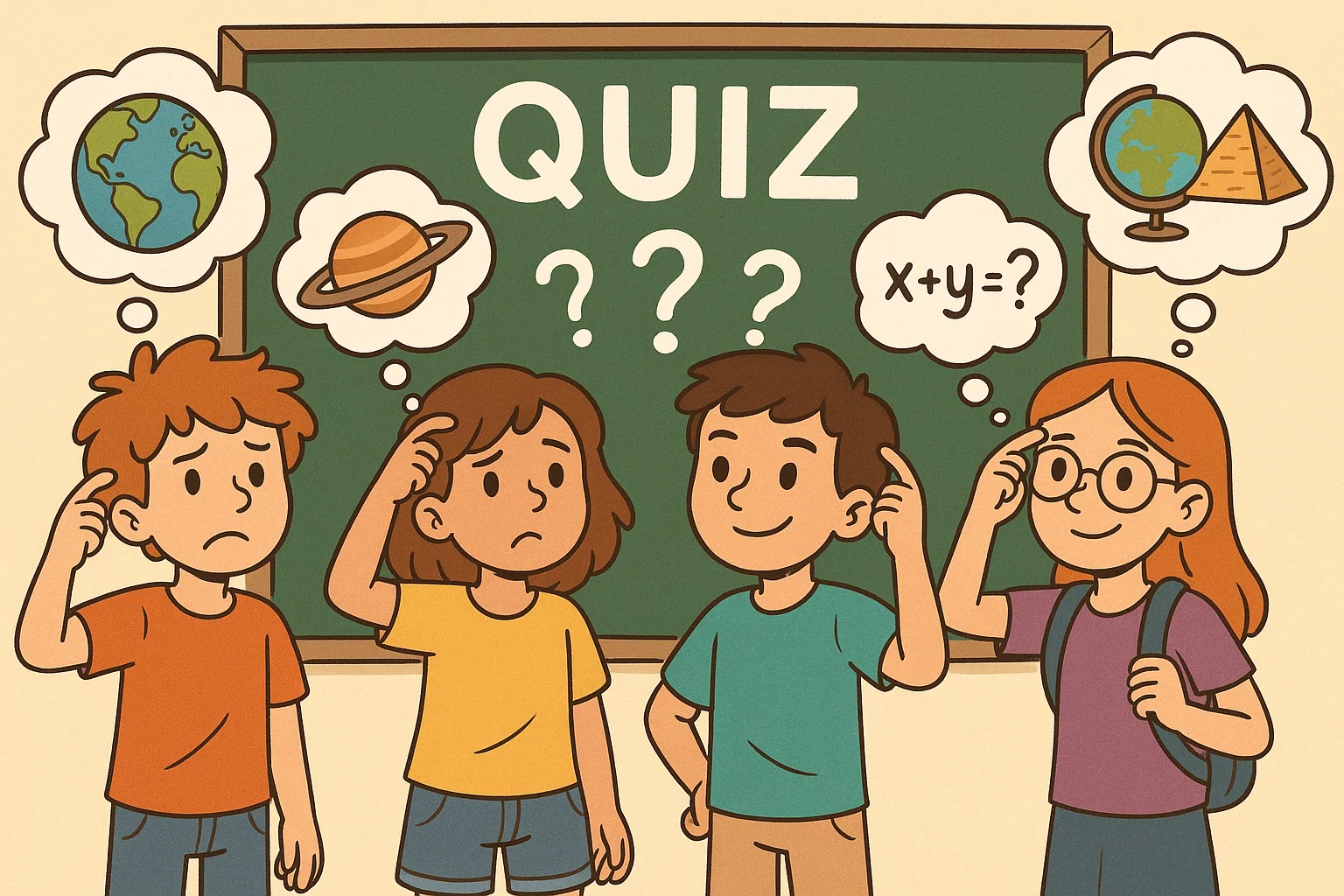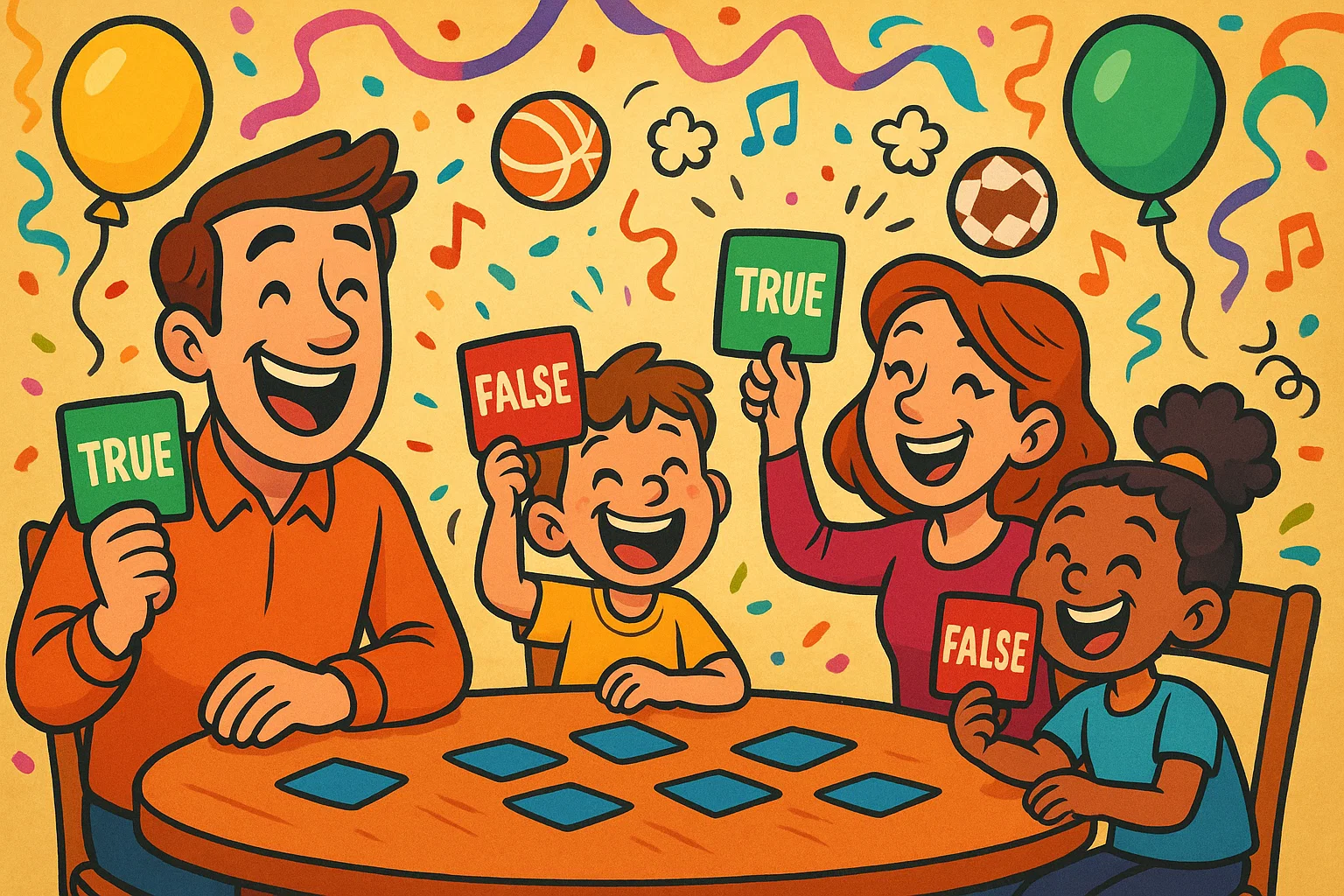True or False Questions for Kids With Answers

Learning can be an adventure, and true or false questions make it both simple and fun. These quick statements spark curiosity, build confidence, and encourage critical thinking by asking kids not just to recall facts, but to evaluate them. For parents and teachers, true or false quizzes are an easy way to boost engagement and reinforce concepts across subjects. Whether you need easy sets for kindergartners or tougher ones for older kids, this guide offers questions on science, math, geography, and pop culture to turn any moment into a fun learning opportunity.
Easy True or False Questions for Kids

For the youngest learners, typically preschoolers up to about six years old, the goal is to introduce new concepts in a non-intimidating way. Easy true or false questions are perfect for this age group, using simple language and familiar, everyday topics. These true or false questions for kids are often based on common misunderstandings, encouraging them to correct a simple statement.
Animals and Nature
These statements focus on familiar animals and basic natural phenomena. They are fun facts that are easily observable or commonly known, making them great for initial knowledge checks.
- The sun sets in the west. (True)
- All birds can fly. (False – Penguins and ostriches cannot fly.)
- Cats purr when they are happy. (T)
- A spider has six legs. (F – Spiders have eight legs.)
- Fish sleep with their eyes closed. (F – Fish do not have eyelids and therefore sleep with their eyes open.)
- Clouds are made of cotton. (F – Clouds are made of tiny water droplets or ice crystals.)
Food and Everyday Life
These statements relate directly to a child’s environment and daily experiences, making the learning highly relatable and tangible.
- Bananas grow on trees. (True)
- We use our ears to taste food. (False – We use our tongue to taste.)
- You should brush your teeth only once a day. (F – You should brush at least twice a day.)
- Pizza is a type of vegetable. (F – Pizza is a prepared food, not a vegetable.)
- A square has three sides. (F – A square has four sides.)
- The color of the stop sign is blue. (F – Stop signs are red.)
Colors and Objects
These focus on simple visual recognition and categorization, which are key skills for early learners.
- The sky is green. (F – The sky is blue or gray.)
- A bicycle has four wheels. (F – A bicycle has two wheels.)
- Red and yellow make the color orange. (T)
- Ice cream is hot. (F – Ice cream is cold.)
- We wear gloves on our feet. (F – We wear gloves on our hands.)
Medium True or False Questions for Kids
Moving up the complexity scale, the following sets are ideal for elementary students, typically ages 7–10. These statements often require a slightly deeper understanding of the world, shifting from simple observation to early conceptual knowledge.
Science Basics
This section introduces basic science true or false concepts, laying the groundwork for more advanced studies on the human body and the cosmos.
- The Earth goes around the sun. (True)
- The human body has over 100 bones. (True – An adult human has 206 bones, and a baby has even more.)
- Magnets are attracted to wood. (False – Magnets are attracted to certain metals like iron.)
- Sound travels faster than light. (False – Light travels much faster than sound.)
- Water boils at 100 degrees Fahrenheit. (False – Water boils at 100 degrees Celsius.)
Geography and Places
These geography questions introduce key landmarks and global concepts, encouraging a broader view of the world.
- The Great Wall of China can be seen from space. (False – While long, it is too narrow to be seen easily without aid.)
- Paris is the capital city of Italy. (False – Paris is the capital of France; Rome is the capital of Italy.)
- The largest ocean on Earth is the Atlantic Ocean. (False – The largest is the Pacific Ocean.)
- Antarctica is the coldest continent. (True)
- Mount Everest is the tallest mountain in the world. (True)
History and Culture
Introducing historical facts helps children connect with the past and understand how great people invented things that shape our present.
- Thomas Edison invented the telephone. (False – Alexander Graham Bell invented the telephone.)
- Dinosaurs lived at the same time as the first humans. (False – Dinosaurs died out millions of years before humans appeared.)
- The first American president was George Washington. (True)
- The Eiffel Tower is located in London. (False – It is in Paris, France.)
Hard True or False Questions for Kids

Designed for older children, typically 10 years old and up, these questions demand a higher level of comprehension and recall. These hard true or false questions are excellent brain teasers and effective for assessing retention.
Advanced Science and Space
These statements delve into complex systems, requiring an understanding of advanced science and astronomical facts.
- A black hole is actually a hole in space. (False – A black hole is an extremely dense region of space with intense gravity.)
- All planets in our solar system have moons. (False – Mercury and Venus do not have moons.)
- The Earth’s core is made mostly of iron and nickel. (True – The outer core is liquid metal, while the inner core is solid.)
- Sound waves can travel through a vacuum, like space. (False – Sound requires a medium (like air or water) to travel; space is a vacuum.)
Literature and Art
These questions test knowledge of classic stories and foundational artistic concepts.
- The main character in The Wizard of Oz is named Alice. (False – Her name is Dorothy.)
- Monet was famous for his abstract, cubist style of painting. (False – Monet was a key figure in the Impressionism movement.)
- In the original fairy tale, the glass slipper belonged to Sleeping Beauty. (False – It belonged to Cinderella.)
- Shakespeare wrote the play Romeo and Juliet. (True)
Pioneering Inventions and Technology
Challenging true or false trivia questions on significant discoveries that altered the course of human history.
- The printing press was invented in the 15th century. (True – Gutenberg invented it around 1440.)
- Antibiotics were discovered by Marie Curie. (False – Penicillin, a key antibiotic, was discovered by Alexander Fleming.)
- The first computer was run using electricity. (False – Early mechanical computers pre-dated the widespread use of electricity in computing.)
Educational True or False Questions for Kids
This section is perfect for classroom settings and reinforcement at home, making learning focused on core school topics exciting. These quizzes are a great way to gauge understanding and quickly boost knowledge across various academic domains.
Math True or False Questions
These questions test fundamental understanding of numbers, operations, and basic geometry.
- The number 0 is an even number. (True)
- A triangle always has four equal sides. (False – A triangle has three sides.)
- Multiplying any number by zero always results in that same number. (False – The result is always zero.)
- 9 is equal to 3 × 3. (True)
- A circle has one corner. (False – A circle has no corners.)
Vocabulary Builder True or False Questions
Focusing on language, these questions help to expand a learner’s word bank and improve comprehension.
- The word ‘synonym’ means a word with the opposite meaning. (False – It means a word with the same or similar meaning.)
- ‘Benevolent’ means kind and good-hearted. (True)
- The opposite of ‘huge’ is ‘enormous’. (False – They are synonyms; the opposite would be ‘tiny’.)
- All proper nouns must begin with a capital letter. (True)
Science True or False Questions
A mixed bag of biology, chemistry, and physics trivium to check broad science knowledge.
- A human heart has four chambers. (True)
- The strongest muscle in the human body is the tongue. (False – The masseter (jaw muscle) is generally considered the strongest.)
- An atom is the smallest unit of matter that retains the properties of an element. (True)
- The process of photosynthesis is how plants make their own food. (True)
Geography and Environment Questions
Focusing on the planet’s systems, from climate to continents.
- The equator is a real, physical line drawn around the Earth. (False – It is an imaginary line.)
- A desert is always a very hot place. (False – Antarctica is a cold desert.)
- Australia is both a country and a continent. (True)
- The Amazon River is the longest river in the world. (False – The Nile River is generally accepted as the longest.)
History and Culture Questions 🏛️
Statements about important historical events and figures.
- The Declaration of Independence was signed on July 4, 1776. (True)
- Ancient Romans spoke the Greek language. (False – They primarily spoke Latin.)
- Christopher Columbus discovered America. (False – Indigenous peoples had lived there for thousands of years, and Norse explorer Leif Erikson reached North America centuries earlier.)
Fun True or False Questions for Kids

Sometimes, learning should just be fun! These fun true or false questions are perfect for informal settings, parties, and family game night. They spark curiosity using entertaining topics like pop culture and sport.
Pop Culture and Movies
Focusing on common media and entertainment that kids love, especially Disney and classic franchises.
- Buzz Lightyear’s famous line is “To infinity and beyond!” (True)
- Mickey Mouse has a dog named Goofy. (False – Mickey’s dog is Pluto; Goofy is a separate character.)
- All of the seven dwarves in Snow White wear glasses. (False – Only one, Doc, wears glasses.)
- The Star Wars movies take place in the past. (True – The famous opening line is “A long time ago in a galaxy far, far away.”)
Sports and Games
Simple sport fun facts that are easy to remember and talk about.
- A marathon race is exactly 26.2 miles long. (True)
- In baseball, a home run always scores three points. (False – A home run scores one point (a run), but can score up to four runs if the bases are loaded.)
- The Olympics are held every year. (False – The summer and winter games alternate every two years, meaning the Olympic Games occur every four years.)
- Chess is considered a sport. (True – It is officially recognized as one by the International Olympic Committee.)
Holidays and Traditions
Questions to help celebrate and learn about diverse cultures and festive traditions, including Thanksgiving.
- Reindeer can fly. (False – But in popular Christmas stories, Santa’s reindeer are said to fly.)
- It is a fact that the first Thanksgiving was celebrated with turkey, stuffing, and pumpkin pie. (False – Historical accounts suggest venison, seafood, and corn were more likely the main dishes.)
- On St. Patrick’s Day, everyone is supposed to wear green. (True)
- The Easter Bunny lays chocolate eggs. (False – Bunnies do not lay eggs; it is a cultural myth.)
Riddles Style True or False
These statements are written as brief brain teasers, adding a layer of puzzle-solving to the knowledge test.
- I have cities, but no houses. I have mountains, but no trees. Am I a type of map? (True)
- I am an odd number. Take away one letter, and I become even. Am I the number seven? (True – Seven becomes ‘even’ when you remove ‘s’.)
- I have a neck but no head. I wear a cap but no crown. Am I a bottle? (True)
True or False Questions for High School Kids
For teenagers, the content must be more challenging and relevant to current world affairs and advanced academic study. This is where you can truly challenge them to think at a deeper level.
Science Brain Teasers
These true and false questions move into advanced concepts like thermodynamics, genetics, and quantum mechanics.
- Water boils faster at the top of a high mountain than at sea level. (T – Lower atmospheric pressure at high altitude means water boils at a lower temperature.)
- A calorie is a unit of mass. (F – A calorie is a unit of energy.)
- DNA is a single-stranded helix. (F – DNA is a double-stranded helix.)
History and Politics
Focusing on critical world events, political systems, and key figures.
- The United Nations was established before World War I. (F – It was established after World War II.)
- Abraham Lincoln wrote the Declaration of Independence. (F – Thomas Jefferson wrote the Declaration of Independence.)
- The term “Cold War” refers to a conflict involving direct military combat between the U.S. and the Soviet Union. (F – It was a period of geopolitical tension without large-scale fighting.)
Pop Culture Showdown
Relevant true or false questions about current trends, technology, and media literacy.
- YouTube was acquired by Google in 2010. (F – It was acquired in 2006.)
- A ‘viral’ video is guaranteed to generate profit for its creator. (F – Virality does not automatically guarantee monetization or profit.)
Tips to Use True or False Questions Effectively

The format of the questions is just as important as the content. To truly boost knowledge and engage your learner, consider these educational strategies and gamified quizzes.
Adapt Questions to Learning Levels
Effective learning is scaffolded. You should use a mix of easy true or false questions and hard true or false questions to ensure success but also to challenge the child.
- Kindergarten to Grade 2: Focus on concrete concepts and visual facts (Colors, shapes, common animals).
- Grade 3 to Grade 5: Introduce basic science, simple math, and geography (Planets, basic arithmetic, continents).
- Grade 6 and Up: Use complex vocabulary, historical dates, and abstract concepts (Advanced human body, physics, complex political trivium).
| Age Group | Focus Area | Goal |
| 4-6 (Easy) | Sensory/Concrete Facts | Building basic knowledge, identifying common objects. |
| 7-10 (Medium) | Conceptual & Simple Subject Knowledge | Introducing academic topics, encouraging simple reasoning. |
| 11+ (Hard) | Abstract & Critical Thinking | Challenge them to think, evaluating complex statements and prior knowledge. |
Gamified Quizzes and Activities
Turn the quiz into an interactive way to boost engagement, making learning an exhilarating competition.
- “Corners” Game: Label the four corners of a room: True, False, “Don’t Know/Need Help,” and “Challenge Statement.” Read the statement, and have kids run to the corner that represents their answer.
- Team Challenge: Divide the classroom or family into teams. Teams gain a point for a correct answer and a bonus point if they can explain why the statement is true or false. This reinforces the importance of knowing the fact, not just guessing.
- “Invent a False Question”: After answering a set, challenge the kids to invent their own convincing false questions with answers for the opposing team. This requires a strong grasp of the material to create a misleading, yet plausible, statement.
Combining With Other Learning Tools
Use these quizzes to reinforce learning from other resources.
- Flashcards: Use printable cards with the true or false statements on one side and the answer and explanation on the back.
- Technology Integration: Create a visually engaging presentation using Google Slides or a similar platform. This is a great way to show accompanying images or video clips that relate to the topic.
- Post-Lesson Review: Always use a short true or false quiz (no more than 10 questions) immediately after covering a new topic. This is a powerful fact to aid in memorization and retention. Research suggests that immediate testing significantly improves long-term recall compared to just re-reading the material (Roediger & Karpicke, 2006).
FAQs About True or False Questions for Kids
What age group is best for true or false questions?
True or false questions are suitable for virtually all age groups, starting as early as kindergarten (ages 4-5) up through high school and beyond. For younger children, they are a simple cognitive exercise based on visual or concrete facts. For older children and teens, they are used as complex brain teasers and effective tools to gauge deep understanding and critical thinking across academic subjects.
How many questions should kids answer at once?
The ideal number of true or false questions varies by age and attention span. For young children (ages 4–7), a set of 5–10 easy true or false questions is sufficient to maintain engagement. For older elementary students, 10–15 questions work well. For middle and high school students, a 20-question quiz is manageable. The key is to keep the session short and learning exciting, aiming for focused interactive time rather than prolonged testing.
Can true or false questions improve critical thinking?
Absolutely. Unlike multiple-choice, which often relies on recognition, or fill-in-the-blank, which tests simple recall, true or false questions challenge young learners to actively evaluate a statement and justify their answer. When a child has to determine whether a complex statement is true or false and then defend their choice, they are engaging in a high level of critical thinking, which helps them to quickly correct and reinforce their knowledge across a wide range of topics. This process helps them move beyond surface-level memorization.
Are true or false quizzes good for exams and homework?
Yes, true or false quizzes are an excellent supplement for both exams and homework. They offer a quick, time-efficient way for teachers to gauge student comprehension and for students to self-test. They are especially effective when used as a review tool, helping students to focus on key facts while making learning an enjoyable, low-pressure experience. You can download many printable worksheets to use these questions as part of a regular homework routine to effectively boost academic performance.
